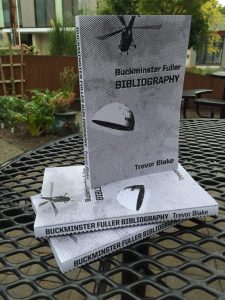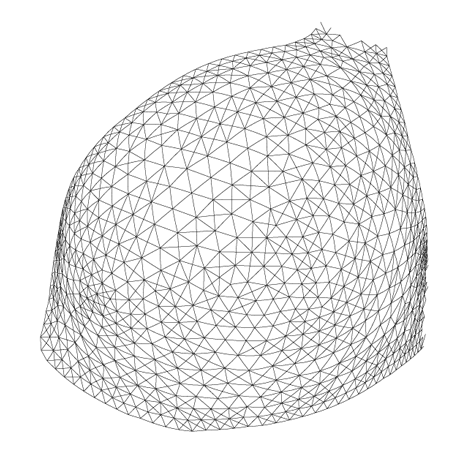Buckminster Fuller Bibliography
Buckminster Fuller Bibliography by Trevor Blake.
One thousand five hundred entries by and about Buckminster Fuller. Books, magazines, newspapers and ephemera published between 1914 and 2015.
Richard Buckminster “Bucky” Fuller (1895 – 1983) was a public speaker, author, mathematician and inventor. Fuller is best known as the popularizer of geodesic domes in architecture. He attempted to apply the most recent discoveries of science to the most basic of human needs such as shelter and transportation, without regard for precedent or profit or power, doing more with less. He called this process design science.
Paperback
260 pages
Introduction, Bibliography, Index
$17.50
ISBN 978-1944651022
The Lost Inventions of Buckminster Fuller - Kindle Edition
Addendum 2016: The complete contents of “The Lost Inventions of Buckminster Fuller” have now been published for free at synchronofile.com.
See BOOKS for more information on Buckminster Fuller Bibliography and other books.
Buckminster Fuller Bibliography - Kindle Edition
Addendum 2016: See BOOKS for more information on Buckminster Fuller Bibliography and other books.
Fuller in Fashion
Fashion is design you wear, mobile and kinetic, including both tension and compression components. Fashion is the valve between the environment (everything except you) and the universe (everything including you). R. Buckminster Fuller’s influence on fashion is an undocumented parallel to his investigation into design.
☂ Fuller was attentive to his appearance. In Your Private Sky (Baden: Lars Muller Publishers 1999), Fuller is quoted as saying:
I decided to make a complete experiment of peeling off from society in general, and started wearing T-shirts which nobody was doing then, went about without a hat and in sneakers - absolutely comfortable clothes. Then when people started getting interested in my Dymaxion House, very nice people with influence, and they’d say, “l’d like to give a dinner party for you” and so forth, I would show up in khaki pants and they’d be very shocked. And when Mrs. John Alden Carpenter, head of the Arts Council in Chicago, gave a beautiful dinner party, I showed up and rudely announced, “I don’t eat that kind of food,” and was in every way obnoxious. l was putting self and comfort ahead of my Dymaxion House, and I said, “You’re not allowed to do that. You must get over that. You must stop that looking eccentric, with everybody pointing at this guy.” So I decided the way to do that was to become the invisible man, and that means a bank clerk - so I put on a black suit, bank clerk’s clothing; then they would focus on what I was saying instead of my eccentricities. I said, “I must get rid of continually making too much of myself.”
Fuller also knew of the attraction of the nude. When he exhibited the Dymaxion House in the 1920s, he placed a nude doll in its bedroom.
☂ Continuum Fashion is the source for this graphic showing one of a pair of irregular geodesic hemispheres…
The graphic is a glimpse into the mathematics of the N12, a bikini designed with a 3-D scanner and printed with a 3-D printer. Continuum writes:
The N12 bikini is the world’s first ready-to-wear, completely 3D-printed article of clothing. All of the pieces, closures included, are made directly by 3D printing and snap together without any sewing. N12 represents the beginning of what is possible for the near future. N12 is named for the material it’s made out of: Nylon 12. This solid nylon is created by the SLS 3D printing process. Shapeways calls this material “white, strong, and flexible”, because its strength allows it to bend without breaking when printed very thin. With a minimum wall thickness of .7 mm, it is possible to make working springs and almost thread-like connections. For a bikini, the nylon is beautifully functional because it is waterproof and remarkably comfortable when wet.
☂ “When I am working on a problem, I never think about beauty but when I have finished, if the solution is not beautiful, I know it is wrong.” This quote is attributed to R. Buckminster Fuller but I cannot find the source. More significantly, the greatest online biographer of Fuller - Joe S. Moore at his incredible buckminster.info - also cannot place this quote. Can you?
☂ Photographer Moria Simmons and a friend went as “Buckminster Fuller and the Geodesic Dame” on Halloween 2008. See Moria’s photograph here, and more of her photography (including a sneaky shot of the Dymaxion Car and the Fuller postage stamp) here. Could this be the same Moria who knitted a geodesic hat?
☂ Laura Dawson is a fashion designer. She used a geodesic dome to exhibit her Fall 2009 collection. (Thanks to grunch.net).
☂ The Buckminster Fuller Institute sells handbags and if memory serves they have sold pins and t-shirts in the past.
☂ Colleen Coghlan designed an inflatable type-two two-frequency geodesic pillow dome garment. She writes: “The inflatable dress (or ‘Wearable Space’) is, as the name describes, a garment that inflates into a personal space to sleep, rest or play within.”
Read more about the Wearable Space at The Cool Hunter.
☂ Connie Chang Chinchio sells a pattern for a geodesic cardigan.
☂ Life Magazine could have published a photograph of anyone assembling a Dymaxion Map in March 1943. They chose a contortionist in her circus uniform.
☂ Fuller Houses by Federico Neder (Baden: Lars Muller Publishers 2008) includes several items of Fuller fashion. The color plates section in the rear of the book shows a lapel pin of the Dymaxion House, presumably sold in the Henry Ford Museum where the Dymaxion House is on display. Fuller Houses also includes a sketch of a Dymaxion Hat designed by Irene Sharaff.
☂ The umbrella is a favored icon at synchronofile because it is a portable relatively inexpensive dome shelter produced on the industrial level. There are endless variations to the umbrella, from a banker’s basic black to the LED umbrellas of the film Blade Runner. The Bucky Bar was raised in February 2010. It was a geodesic dome made up of umbrellas designed by DUS Architects as a spontaneous (and unauthorized) dance bar in Rotterdam.
☂ Hair stylists Andreas and Markus contributed a two-frequency type two geodesic sphere hair weave to a fashion shoot by Purebred Productions.
☂ Florida-based Emilie produces beaded jewelry informed by energetic-synergetic mathematics.
☂ My first tattoo, which I gave myself around 1989, is a geometric shape referencing the work of Buckminster Fuller. No photographs of my tattoos have ever been published.
☂This essay first published on the twelfth of July 2011, a day of great significance to Buckminster Fuller.
- Trevor Blake
Trevor Blake is the author of the Buckminster Fuller Bibliography, available at synchronofile.com
Synergetics Stew June 2011
The Buckminster Fuller Institute published the book Synergetic Stew: Explorations in Dymaxion Dining in 1982. Under this name, synchronofile.com publishes an irregular collection of brief notes relating to Buckminster Fuller.
☂ You are Listening to Deep Thoughts is a simple mix of a gentle background image, a quiet ambient music track and a recording of a thoughtful public speaker. More often than not, the thoughtful public speaker is R. Buckminster Fuller.
☂ “Network Awesome is a platform for entertaining and interesting TV. We spotlight the best from the past to create something new for the future. In a sense it’s TV about TV but our wider intent is to show something about culture as a whole. This can manifest itself in a kids cartoon from 1973, an interview from 1948 or a movie from 1993 – We’re pretty open minded about what Network Awesome is and what it can be. It’s our commitment to provide you what we think is interesting and clever TV - hopefully you agree.” Video of R. Buckminster Fuller regularly appears on Network Awesome.
☂ A Picture History of Shelter Systems is just what it says on the box. Founder Bob Gillis owns several key patents for modern camping tents that meet Fuller’s criterion of portability, tension rather than compression, curves and triangles rather than straight lines and 90-degree angles, industrial production and low cost. While there are many sculptures and models that use Kenneth Snelson’s tensegrity method, Gillis may be the only man to have created a tensegrity structure for habitation as Fuller advocated.
☂ On 3 July 1980 Fuller spoke as Visiting Consultant for Windstar in Snowmass Colorado USA. Co-founder of Windstar John Denver wrote a song for Fuller that year titled What One Man Can Do. A popular photograph from Fuller’s visit to Windstar shows him with the Dymaxion car and a Fly’s Eye dome. The Dymaxion Car was restored last year, and now the Fly’s Eye dome has also been restored. The dome will be on exhibit at Art Basel, Design Miami and Dacra, all located in Miami Beach Florida USA.
☂ As previously announced, D. W. Jacob’s play R. BUCKMINSTER FULLER: THE HISTORY (and mystery) OF THE UNIVERSE was performed 28 May – 4 July 2010 at the Arena Stage Crystal City in Washington, DC USA. Perhaps for the first time, scenes from the play are now online. See also this trailer from the Portland performance in 2008, and Jacob and Allegra Fuller-Snyder talking about the 2011 run here. I’m glad to have seen the play several times over, but I do hope it is filmed in full some day.
- Trevor Blake
Trevor Blake is the author of the Buckminster Fuller Bibliography, available at synchronofile.com
R. Buckminster Fuller’s Influence on Science Fiction Films and Television
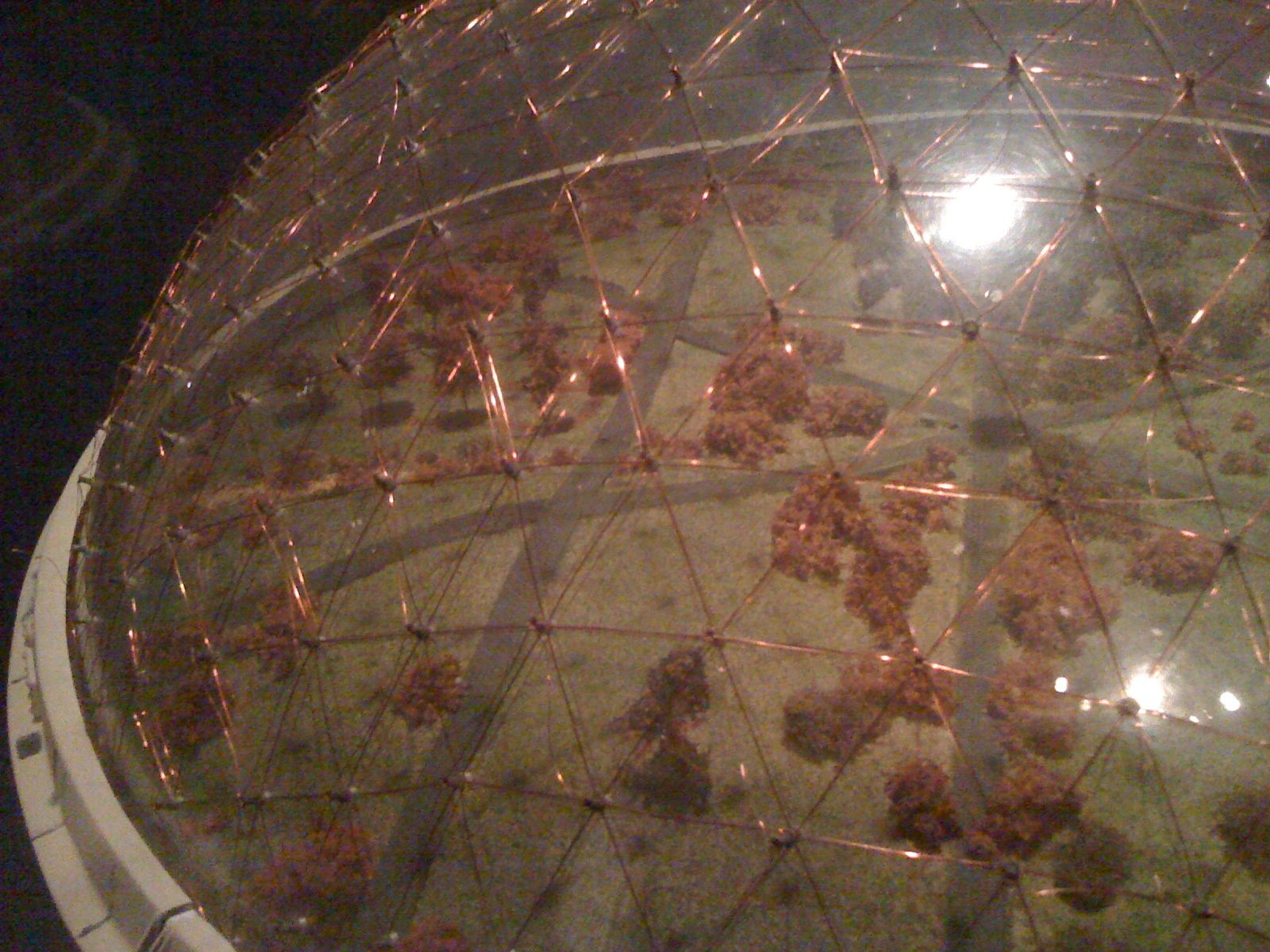
R. Buckminster Fuller’s influence on science fiction films and television during his lifetime (12 July 1895 – 1 July 1983).
First Spaceship on Venus
[Wikipedia] [IMDB] [youtube]
1960. Film. Directed by Kurt Maetzig. Based on the novel The Astronauts by Stanisław Lem. An international rocket crew finds geodesic domes on the planet Venus.
Earth II
[IMDB]
1971. Television. Directed by Tom Gries. A space station makes a claim for independence from the Earth it orbits. R. Buckminster Fuller is credited as the “Technical Advisor for Earth” in Earth II. Fuller’s Dymaxion Map is used to track orbiting satellites in an Earth-bound control room.
Slaughterhouse 5
[Wikipedia] [IMDB] [youtube]
1972. Film. Directed by George Roy Hill. Based on the novel Slaughterhouse Five by Kurt Vonnegut Jr. Billy Pilgrim is kept in a geodesic dome in a zoo on the planet Tralfamadore.
Silent Running
[Wikipedia] [IMDB] [youtube]
1972. Film. Directed by Douglas Trumbull. The spaceship Valley Forge includes several geodesic domes.
The Starlost
[Wikipedia] [IMDB] [youtube] [The Starlost: The Word]
22 September 1973 – 5 January 1974. Television. Directed by Leo Orenstein. Created by Harlan Ellison. Executive Producer was Douglas Trumbull of Silent Running. A geodesic dome from the spaceship Valley Forge from Silent Running is re-used on the spaceship The Ark.
Battlestar Galactica
[Wikipedia] [IMDB] [Battlestar Wiki: Agro Ship]
September 17, 1978 – April 29, 1979. Television. Created by Glen A. Larson.
The geodesic dome from the spaceship Valley Forge from Silent Running which had been re-used on the spaceship The Ark in The Starlost is re-used once more on an Argo Ship. This dome is on exhibit at the EMP Science Fiction Museum between 23 October 2010 - 4 March 2012.
See also LOST Domes.
- Trevor Blake
Trevor Blake is the author of the Buckminster Fuller Bibliography, available at synchronofile.com
Synergetics Stew January 2009
The Buckminster Fuller Institute published the book Synergetic Stew: Explorations in Dymaxion Dining in 1982. Under this name, synchronofile.com publishes an irregular collection of brief notes relating to Buckminster Fuller.
☂ BLDGBLOG writes about the myriahedral projection map of computer scientist Jack van Wijk (Eindhoven University of Technology in the Netherlands). “Making truly accurate maps of the world is difficult because it is mathematically impossible to flatten a sphere’s surface without distorting or cracking it. The new technique […] uses algorithms to ‘unfold’ and cut into the Earth’s surface in a way that minimizes distortion, and keeps the distracting effect of cutting into the map to a minimum.” Compare van Wijk’s work with Buckminster Fuller’s Dymaxion Map and with Butteryfly Map of Bernard Joseph Stanislaus Cahill.
☂ Speaking of Cahill, Gene Keyes has published a comparison of Cahill’s Butterfly Map and Fuller’s Dymaxion Map. Gene was a student of Fuller’s at Southern Illinois University in Carbondale, Illinois. Nearly 40 years ago Gene wrote Bucky and Pick: Two Grand Designers of a World Without War. An Essay-Review of Robert Pickus (To End War) and R. Buckminster Fuller (Utopia or Oblivion). Fuller sent a handwritten letter to Norman Cousins (editor of Saturday Review) urging Cousins publish the essay. The essay has never been published - until now.
☂ The Imaginary Foundation is selling an “All-Star Pattern Seeker Trading Cards pay tribute to 23 giants of pattern recognition - pathfinders and ideanauts whose shadows loom large across three millennia of discovery. This set of 23 cards comes in a collectible embossed box.” Buckminster Fuller is one of the all-star pattern seekers so honored.
☂ Playboy Magazine mentions Fuller in the profile of Susan Miller (Miss September 1972) and an interview with Allen Ginsberg but some other Fuller information hasn’t made it online yet. This includes the Playboy article “Cities of the Future” from January 1968 and an interview from February 1972. Buckminster Fuller: Anthology for a New Millennium edited by Thomas Zung incorrectly cites Fuller’s Playboy interview in the year 1970. Fuller makes some remarkable claims in his Playboy interview… “I’m not surprised to see women getting naked, because the more naked they are, the more they tend to discourage the sex urge. If a woman is covered up with skirts, man is driven by curiosity. Take away the skirts and he says to hell with it. And I find us getting an enormous amount of homosexuality, which I see as nature supplying us a negative urge that diminishes our capacity to make babies.” “Man probably came to this planet as whole man, a creature very much like what we see today. He might have been sent by electromagnetic waves.” “You could take human beings and inbreed them until you came up with a monkey. You can see that happening every day. Lots of people are halfway to monkey.” See also Buckminster Fuller, Creationist.
☂ Science Daily writes that Salvatore Torquato (Princeton Institute for the Science and Technology of Materials) and Yang Jiao (Department of Mechanical and Aerospace Engineering) have bested the world record set last year by Elizabeth Chen (University of Michigan) for tetrahedra packing. “Torquato and Jiao were able to fill a volume to 78.2 percent of capacity with tetrahedra.” Buckminster Fuller made no specific claims about the closest packing of tetrahedra but would likely have found this discovery of interest.
☂ synchronofile.com had the honor of announcing the restoration of the Dymaxion Car in September 2009. This resulted in a spike of interest in the car both on and off the Internet (see below). Crosthwaite and Gardiner, the company trusted with the restoration, have published some remarkable photographs of their work in progress here and here. Your help is still needed in identifying the source components used in the original Dymaxion Car.
☂ Noel Murphy is filming a documentary titled The Last Dymaxion. “One of the greatest minds of our time designed the very first green car. Certain corporations destroyed the possibility of that car ever being produced, but now, in the 21st century, the last Dymaxion is being restored, and along with it Buckminster Fuller’s Dream.” Noel is also the author/lead in the play Buckminster Fuller Live. The Last Dymaxion is scheduled for release Christmas 2010.
☂ The 1929 automobile of Engelbert Zaschka exhibited features that were important to Fuller. It was a three-wheeled car, like his Dymaxion. But it could also easily be folded, disassembled and re-assembled as could Fuller’s Dymaxion House and many geodesic domes. Zaschka was an advocate and pioneer inventor for the personal helicopter, achieving Fuller’s goal of a personal omnidirectional transportation vehicle. More information at Wikipedia (English, German) German-language excerpt from a television documentary on Zaschka here and a short film of the Zaschka being disassembled here.
☂ Hillary Louise Johnson wrote Super Vixens’ Dymaxion Lounge in 1997. Chapters one through six of Super Vixens’ Dymaxion Lounge are now online. Salon described the book as “a slim but wickedly brutal take on existential life in modern L.A., and one woman’s quest for depth amidst the neon-drenched chaos and urban (not to mention urbane) sprawl. With a toddler in tow all the while. […] Much of the book focuses on Johnson’s search for a way past such hackneyed responses, but she’s also aware of how difficult that is in a town where, a friend tells her, ‘style is substance.’ L.A. is a ‘dymaxion’ town, a term used by Buckminster Fuller to describe a world unto itself, where everything intermeshes and everything is available. So she’s wise enough to know that the idea of breaking through clichés is a cliché itself. Is she really going to be gratified by seducing the Little Caesar’s delivery boy, dating a couple, hanging out with drag queens? Nothing’s ironic in a town built on irony; a teacher at a Montessori school placidly tells Johnson that ‘the playground’s in the backyard, very safe from drive-by shootings.'”
☂ D. W. Jacob’s play R. BUCKMINSTER FULLER: THE HISTORY (and mystery) OF THE UNIVERSE will be performed May 28 - July 4, 2010 at the Arena Stage Crystal City in Washington, DC. Doug tells me: “Crystal City has put out an international call for artists to create outdoor works of art around Bucky themes and concepts, etc.” More information available from the Arena Stage.
☂ Kirby Urner was the first webmaster for the Buckminster Fuller Institute (bfi.org circa 1996 via archive.org). His sites 4D Solutions and grunch.net were some of the first and best online for Fuller mathematics. He was a consultant for textbook publisher McGraw Hill and continues to serve as an educator. Kirby is involved in the Thunderbird Early College Charter School, IEEE, Leadership & Entrepreneurial Public Charter High School, python and linux development and much more. Sometimes Kirby openly promotes Fuller in his educational work, sometimes he works in stealth mode. See a little of both in action at the Oregon Curriculum Network. Kirby’s style is that of a river: as deep as it flows, it also flows swift. He’s on to the next problem before you dry off from the first. Try to catch up with Kirby via Grain of Sand, Control Room , Coffee Shops Network, and the BizMo Diaries. Each of these is generously illustrated with his flickr photo stream.
- Trevor Blake
Trevor Blake is the author of the Buckminster Fuller Bibliography, available at synchronofile.com
Dymaxion Car Restored
Addendum, 2016: this article was the first public announcement of the restoration of the Dymaxion Car. Since that time, the Dymaxion Car has been restored. For more information on the Dymaxion Car, see synchronofile.com.
The Dymaxion Car of R. Buckminster Fuller is being restored by the company Crosthwaite and Gardiner.
Dymaxion Car #1 was involved in a fatal accident, restored, and later accidentally destroyed in a fire. Dymaxion Car #3 was was bought and sold many times (including being bought and sold by Fuller) and disappeared in the 1950s. It may have been sold as scrap during the US-Korean war. Two of the three Dymaxion Cars are lost forever.
Dymaxion Car #2 was produced by Fuller, Starling Burgess and the 4D Dymaxion Car factory in Bridgeport, Connecticut in 1933. The company that produced the car collapsed in 1934 and Fuller relinquished the vehicle to his employees in lieu of wages. It was discovered in California in the 1960s, having been abandoned. Dymaxion Car #2 was later purchased for the National Automobile Museum in Reno, Nevada USA. The Museum superficially restored the exterior of Dymaxion Car #2. In addition to being displayed at the National Automobile Museum, it was displayed at the Museum of Science and Industry in Chicago in 1973 and the Whitney Museum in New York in 2008. Crosthwaite and Gardiner is now conducting a detailed restoration of the exterior and partial restoration of the interior of Dymaxion Car #2.
Trevor Blake of synchronofile.com has been providing essential research material on the Dymaxion Car to Crosthwaite and Gardiner since February 2009. C&G researcher Phil King wrote: “More and more details are slowly coming out from the archives and from people like yourself, but I must say your information has been the most informative and the most prolific so far. […] I know I keep saying it but your help has been fantastic and you have made a difference.”
synchronofile.com has been granted the great honor of announcing the restoration of the Dymaxion Car - because our readers are now invited to help in the project. Can you identify the manufacturer for this component?



These three photographs depict a component of Dymaxion Car #2. In the US they are called ‘turn signals.’ In the UK they are called ‘indicators.’ It may have been manufactured for a trolley (UK: tram) or a bus. If you can identify the manufacturer for this component please send your answer to Phil King of Crosthwaite and Gardiner at the address below. Say synchronofile.com sent you - and watch this space for further announcements…
- Trevor Blake
Trevor Blake is the author of the Buckminster Fuller Bibliography, available at synchronofile.com
Resources:
- Crosthwaite and Gardiner are specialists in the manufacture of race engines, gearboxes and spare parts for the historic race car industry since 1969. For more information, please email Phil King and see: http://www.crosthwaiteandgardiner.com/
- The Lost Inventions of Buckminster Fuller (Part 2 of 3) by Trevor Blake includes information on the intellectual property issues surrounding the Dymaxion Car.
- Dymaxion Car at Wikipedia.
- Dymaxion at Three Wheelers.
- Motor Vehicle, the patent for the Dymaxion Car.
- Isamu Noguchi’s wooden model of the Dymaxion Car, and Isamu Noguchi seated in the actual Dymaxion Car.
- Buckminster Fuller by Martin Pawley (New York: Taplinger 1990) contains the most detailed information on the Dymaxion Car published to date.
Buckminster Fuller and the Twelfth of July
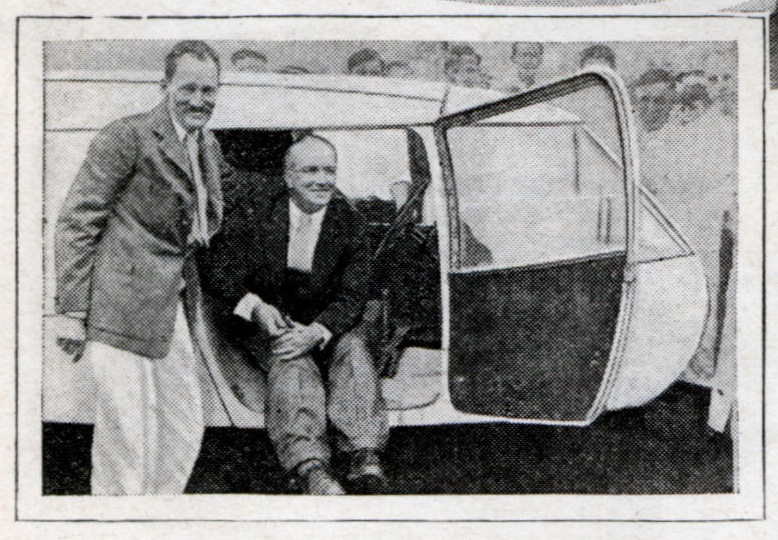
Starling Burgess and R. Buckminster Fuller, Dymaxion Car. Modern Mechanix Magazine October 1933.
All of the following occurred on the twelfth of July…
1895 Richard Buckminster Fuller was born.
1910 Richard Buckminster Fuller Senior, Fuller’s father, died.
1917 Fuller married Anne Hewlett.
1933 Fuller completed Dymaxion Car #1.
1938-1939 ‘the main system of general education instruction to go on the air and screen’ according to Fuller’s book Nine Chains to the Moon.
1938 Roger Hewlett wrote a poem for Fuller titled One Chain to a Room.
1940 Fuller vacationed with Christopher Morley and conceived the Dymaxion Deployment Unit.
1957 a United States Marine Corps dome was lifted by helicopter from the deck of the USS Leyte.
1957 Fuller received an honorary doctorate from Washington University in St. Louis, Missouri USA.
1966 Fuller lectured at a NASA Symposium at Southern Illinois University Institute of Technology in Carbondale, Illinois USA.
1967 the Montreal Biosphère was dedicated by Fuller to Anne as a wedding anniversary gift.
1969 the first Public World Game was played in New York City, New York USA.
1970 Fuller received an honorary doctorate from Columbia College in Chicago, Illinois USA.
1974 Matthew Meyerson wrote a haiku for Fuller in the Synergetics Cookbook.
1976 Fuller received and honorary doctorate from the University of New Mexico.
1980 John Cage wrote a poem about Buckminster Fuller.
Fuller died in 1983. Here are some Fuller-related events that happened on the twelfth of July…
1984 a commemorative exhibit titled In Memoriam R B F was shown in Singapore.
1999 Your Private Sky: R. Buckminster Fuller edited by Joachim Krausse published.
2000 Ron Campbell performed Buckminster Fuller: The History (and Mystery) of the Universe at the Lorraine Hansberry Theater in San Francisco, California USA.
2003 the Artaud Theater in San Francisco hosted a Buckminster Fuller birthday tribute.
2004 the US Postal Service issued a stamp honoring Buckminster Fuller.
2008 Bucky’s Ge-Odyssey presented by The Center for Architecture Foundation in New York City, New York USA.
2008 synchronofile.com launched.
2016Trevor Blake published Buckminster Fuller Bibliography.
- Trevor Blake
Trevor Blake is the author of the Buckminster Fuller Bibliography, available at synchronofile.com
Buckminster Fuller and the Homeless of New York
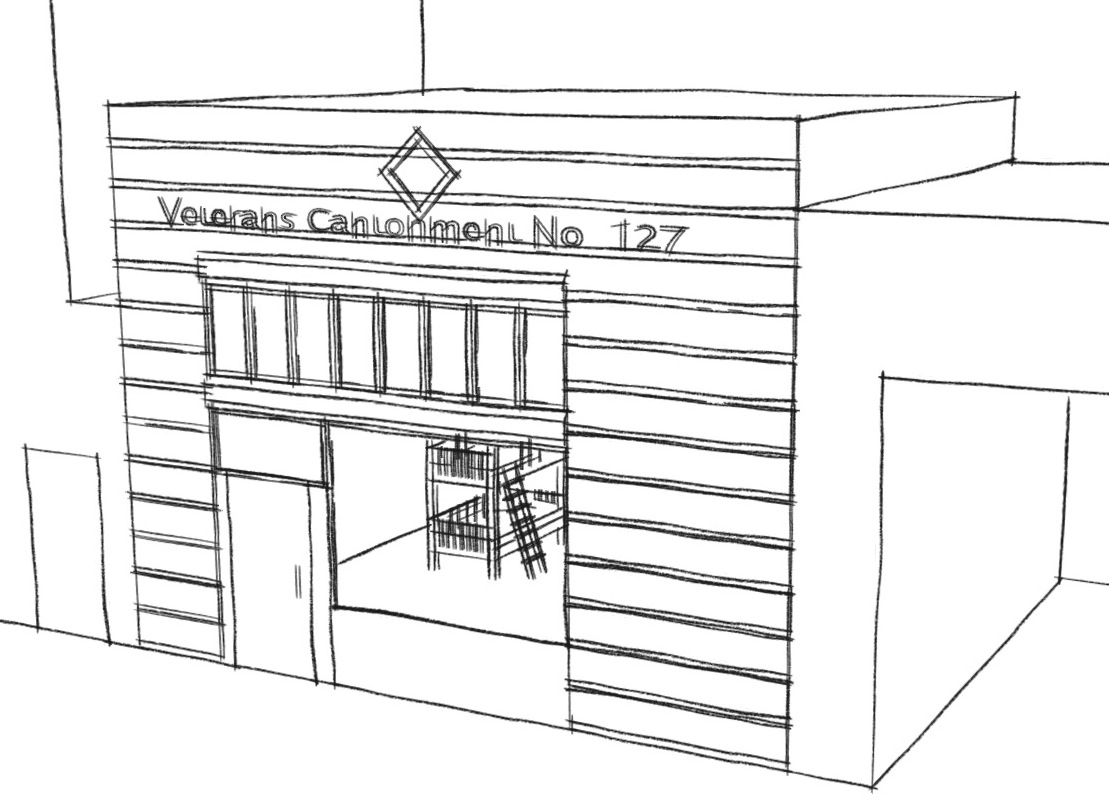
If Buckminster Fuller is known for any effort, it is the effort to provide shelter. But who did Fuller actually provide shelter for? The Lightful House and 4D House existed only on paper. The Dymaxion House existed only as a small scale model. The Dymaxion / Wichita House existed as two full-scale models (one internal, one external, neither able to be connected to the other). The Dymaxion Deployment Unit did house a small number of US armed forces personnel but the DDU was the invention of Victor C. Norquist, not Buckminster Fuller. The geodesic dome was invented by Walter Bauersfeld. Of the dozens of books by and about Fuller, of the thousands of articles on his life and work, most of them fail to give a single instance of when Fuller actually provided shelter to anyone. The Buckminster Fuller Bibliography by Trevor Blake is the first book to document that Fuller provided shelter for others with his own direct effort.
The New York Times for 10 September 1932 includes an uncredited article titled “Single Jobless Men to Get Lodging House / Social Worker and Engineer Obtain Use of Tenement for Those Ineligible for City Aid.” The building in question was a then-deserted seven-story building located at 145 Ridge Street in New York City, New York. The social worker was Ben Howe and the engineer was Buckminster Fuller. Fuller is described as “editor of the magazine Shelter and head of Structural Study Associates, an engineering firm.” According to the article, the men who were renovating the building were hoping to live in it afterward. They were otherwise ineligible for benefits because they were not the head of a family. The building was to house two hundred and fifty men at a time and serve several thousand during Winter. Lieutenant R. E. Johnson was also involved in this project. He is described as a “former army construction engineer and commander of the United States Ex-Service Men’s Association.” At the time of the article, the shelter was under construction. The building described in this article no longer exists.
The New York Times for 2 December 1932 includes an uncredited article titled “Jobless Veterans Back in Barracks / 300 Single Men to Live Under Military Rule in Converted Clubhouse in 54th St.” The building in question was a five-story converted boy’s club at 340 East 54th Street in New York City, New York. According to the article, the shelter would be run by and for veterans and in a military style. The shelter would serve single men because of their difficulties in obtaining relief from existing services. The plan was initiated by a meeting of representatives of various interested organizations at the office of Raymond V. Ingersoll. Ingersoll served as a New York Parks Commissioner and as a Brooklyn Borough President. A residential development named after Ingersoll stands today at 120 Navy Walk in Brooklyn, New York. The representatives at the meeting included Ben Howe and Buckminster Fuller of the 145 Ridge Street shelter, Philip Hiss, Colonel Walter L. DeLamater, Arthur Huck, Louis Gleich, Owen R. Lovejoy, Cyrus C. Perry, James R. Sichel and Henry C. Wright. Philip Hiss went on to design and build homes in Florida, although he was not a trained architect. Col. DeLamater served in the 71st Infantry Regiment, an organization of the New York State Guard. Arthur Huck worked on numerous homeless shelter projects in the New York area, as reported in decades of articles found in the New York Times. Louis Gleich was a commander in the New York County Council of the Veterans of Foreign Wars and was the chairman of the committee that erected a VFW monument in Union Square. Owen Lovejoy served as the General Secretary of the National Child Labor Committee. The building formerly housed the Kips Bay Boys’ Club, where Lovejoy served as secretary. The building was to be called Veterans Cantonment No. 1. At the time of the article, the shelter was in operation. The building described in this article may still exist, next to the building that currently is designated as 340 East 54th Street.
By 1932, Buckminster Fuller had published drawings of his 4D House and exhibited models of his Dymaxion House. He had been featured in the Chicago Evening Post, Fortune Magazine, the Harvard Crimson, Modern Mechanics Magazine, the New York Times and Time Magazine. Fuller had published his monograph 4D and was publishing Shelter Magazine. He had earned the rank of Lieutenant Junior Grade in the United States Navy. In 1933 Fuller would begin work on the Dymaxion Car.
What makes these homeless veteran shelters distinct from any other that Fuller was involved with was that they provided actual shelter to actual men. While they do not have the glamor of Fuller’s Dymaxion House and other creations, they hold the advantage of having existed. Giving a new purpose to an existing structure was an idea that Fuller seldom developed but never abandoned. In his 1970 book I Seem to Be a Verb, Fuller wrote: “Our beds are empty two-thirds of the time. Our living rooms are empty seven-eights of the time. Our office buildings are empty one-half of the time. It’s time we gave this some thought.”
- Trevor Blake
Trevor Blake is the author of the Buckminster Fuller Bibliography, available at synchronofile.com
Reference:
71st Infantry Regiment (New York). 1 April 2009. Wikipedia. 22 May 2009. http://en.wikipedia.org/wiki/71st_Infantry_Regiment_(New_York)
Davis, Edwards: “Advocates the Standardizing of Industry by Law.” New York Times [New York City, New York] 27 July 1913: SM14
Fuller, R. Buckminster. I Seem to Be a Verb. New York: Bantam Books, 1970.
Ingersoll, Raymond V. Houses. 2009. New York City Housing Authority. 22 May 2009. http://www.nyc.gov/html/nycha/html/developments/bklyningersoll.shtml
“Louis Gleich, 69, Dies.” New York Times [New York City, New York] 26 Sept 1961: 39.
“Philip H. Hiss 3d, 78, Designer of Buildings.” New York Times [New York City, New York] 4 November 1988: B4.
Sieden, Lloyd S. Buckminster Fuller’s Universe. Cambridge: Perseus Publishing, 1989.
